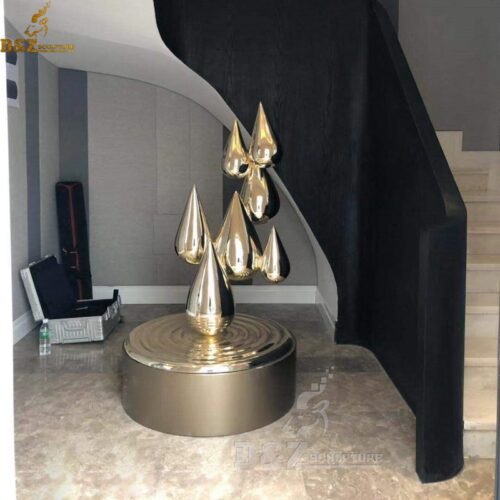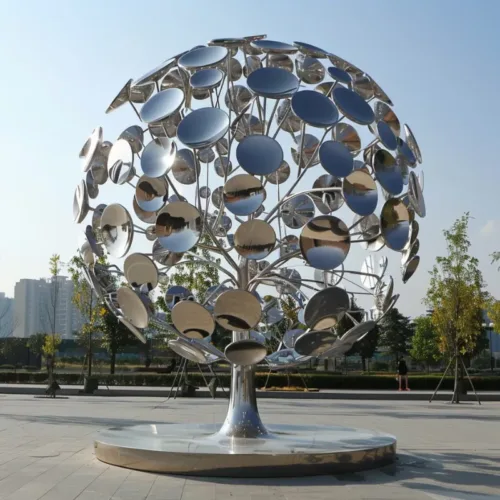
stainless steel water drop sculpture mirror finishing for outdoor garden DZM 1044
SKU
abstract mirror finishing sculpture for sale ,art sphere sculpture
1. Products NO. : DZM-1044
2. Material: Stainless steel /#304
3. Thickness:more than 2mm
4. Size:Custom made depends on your prefer
5. Color: custom made depends on your prefer
6. Package: strong wooden cases
7. Service: Free design, creation, door to door delivery
8. advancement: Factory directly
9. Guarantee: more than 30 years
10. MOQ: 1pc
Description
Water drop sculpture
When it comes to the shape of a sculpture, you may often be surprised. Isn’t there a real object that has a shape? This is not true. We think that a piece of mud has no shape, but a broken brick has a very shape. We say that the shape of sculpture art is different from the shape of the natural state. Generally speaking, the concept of sculpture usually refers to the entity occupying three-dimensional space, and the entity itself is expressed as line, volume, weight, space, mechanism, texture, The collection of colors and lustre becomes an organic whole, that is, the body, and this body moves in space, with a sense of space and direction, so it produces a visual impact, a sense of movement, tension and life. Create, so as to achieve a specific spiritual image, and finally successfully convey the author’s thoughts and emotions.
The so-called sculptor is such a player. We say that the military strategist arranges his troops to form a line, and this is his stuff. The oil painter plays with colors, the composer arranges the melody, and the filmmaker uses images to express his feelings and thoughts. Important linguistic forms and artistic features. Therefore, the sculptor’s housekeeping skill is to play with shapes and create a good-looking shape that can be touched, felt, and meaningful. This is its uniqueness and artistic value. But unfortunately, we often see that some sculpture works lack the concept of three-dimensional space. This question seems to be paradoxical. How should it be explained? I remember Mr. Qian Shaowu gave such an example. His drama and life are very similar, but the scenes and J Sui Jing in life cannot be equated. When the plot state is copied from the stage, it is impossible to watch the play, such as the voice and actions of the speech, the drama should be exaggerated and condensed, and the details should be increased or decreased according to the theme. This is the necessary processing of the drama. In life, it is almost ignored and inaudible in a low voice, but on the stage it needs to be strengthened for the audience, exaggerating the vocals and detailed movements, so that the audience can clearly hear and feel it, so it is considered a mature drama. On stage. On the surface, drama and life are very similar, and it can be copied, but there are essential differences in subtlety. Such an example can be used to explain the difference between form and natural form in sculptural art.
1. What is shape
We believe that the shape is complete, the shape is specific and has individual characteristics, and the shape has spatial form and vitality. In Chinese plastic arts, there are Chinese characters, wood characters, by characters, wind characters, faces, etc. This is the basic concept of shape. The residual bricks have a distinct concept of height, length, width, and three dimensions. They have clear decency and turning points in different directions, so they constitute a stable and complete Three-dimensional space, this is a form, a complete form with volume. In normal times, why many sculptures are small in size, but they feel very grand when they take pictures, and the scene is very tense and imposing. On the contrary, although some large-scale sculptures are tall, they still feel like small toys without weight. It looks good up close and disappears into the air from a distance. Small sculptures are small in size, as long as they are tangible, they can still catch your eye from a distance. This is the role of shape. As long as a child can create a very tangible figure when playing with a clay figurine, which looks good, complete and vivid, ancient Chinese pottery figurines are a good example. Flat and rectangular, the limbs are in the shape of a stick, and the whole is connected together to form a large shape. The shape of the sculpture is to use the shape to shape and use the shape to convey.
2. The glorious history of sculpture in ancient China
From the stone carvings of Qianling in Xi’an at the Longmen Grottoes to the wood carvings in Huizhou in Hongcun, Anhui, they are all glorious masterpieces that describe the gods in form. Our ancestors created countless Buddha statues with Chinese regional cultural characteristics and feudal ethics and character stories and architectural decorations with their talent for shape. These wonderful masterpieces are amazing. Today, we have no way of knowing how they cultivated a ‘literary and military art’ ‘, but we know that their results are inherently creative. When we look back on today in the 21st century, we feel a sense of daze and loss that is completely chronological. We often mention the smooth and graceful lines in feature TV films or in literary discussions on ancient sculptures. When it comes to the beauty of the shape and the characteristics of the shape of the statue, it seems to be invisible. is a freehand conclusion. In fact, on the contrary, the author believes that ancient Chinese sculpture is very particular about the research and production of shape, and its shape has integrity, integrity, and has a strong national style and personality.
(1) Look at a stone statue in the Northern Wei Dynasty
This is a half body shape, very complete. Looking from the side, the belly is straight and a dynamic rhythm. The flat shape overall looks very warm and elegant, the posture is very imposing and charming, its demeanor is unrestrained and unrestrained, the shape is simple and simple, and the slope treatment of each turning is rich and profound, especially the belly. Some of the round and bulging shapes are rich and simple. Seeing this, we can’t help but be amazed by the subtle undulations of their rounded shapes, and strongly feel the splendor and variety of shapes, what is chic and what is romantic. Its spiritual atmosphere and the style of the times are radiated through the complete shape and are vividly displayed. This completes the expression from form to artistic conception, and the high integration of form and meaning.
(2) A model of Western realistic figurative sculpture
Although its realistic style focuses on the depiction and reproduction of skeletal muscles. However, it also pays attention to the training of the basic shape of the human body. The movement changes of its muscles only constitute a change of shape more truly, and different shapes are generated with the trend of the muscles. This shape occupies a three-dimensional shape, which is an important thing to grasp and strengthen when shaping an image. kernel. Therefore, we sometimes forget the structure of the overall shape in order to grasp the changes of the muscles, and ignore the awareness of the accompanying shape in order to describe the muscles and bones, so that the whole work has no overall shape but only the interspersed beginning and end of muscles, which is serious Misunderstanding. In clay sculpture sketching, if there is no shape, it means that there is no spatial relationship, and without the strength and vitality of sculpture language, the aesthetic characteristics of sculpture art will not exist. In fact, what is the language of sculpture? If you know the shape, you can have the language of sculpture. In sketching, you are accumulating the observation and understanding of the shape from the natural creation through the practice of the human body. The structure of different shapes is like a child learning to speak. A little bit of accumulation in order to enrich, and finally be handy to use in the creation of sculptures to express the author’s thoughts and feelings. Therefore, the awareness and possession of shape is an important basis for measuring whether an author is a sculptor.
3. Shape as the ultimate and expressive form of modern abstract sculpture
The development of Western realistic sculpture to modern abstract sculpture is generally considered to be deformed sculpture, that is, from a realistic figurative form to a non-figurative form. It was originally a head shape, but later only one form was seen, and the symbol of the real appearance was lost on the surface. For example, the facial features such as eyes and ears are removed, leaving only the transformation of its undulating space and shape. At this time, only the pure relationship between shape and space is there, that is, the concrete features are stripped away, the shape-space relationship is left, and the shape and structure are based on The reorganization of the spatial proportion is the abstract sculpture. Here is still form, a pure game of form. Therefore, abstract sculpture is not to make realistic images different, to become unreal, weird is called deformation, and deformation must be deformable. In fact, abstraction is to strip away the essential characteristics of the appearance and go directly to the image, and at the same time achieve the complete manifestation of the spirit, which is more like, rather than weird and different. Therefore, the role of shape is particularly emphasized here. Let’s take a look at Brancusi’s “Bird in the Sky”, it is just a simple and concise form, the spiritual consciousness of the bird is concentrated and manifested, thanks to the strength of the form. Henry Moore’s “Emperor and Empress” can also see the basic shape extracted from the human body, using the shape to tell you whether it is a man or a woman, its identity and overall image.
4. Intangible sculptures abound
The lack of awareness of shape makes many sculptures lose their unique artistic charm, and they cannot be called sculptures in the true sense, because sculptures speak with shapes after all. For example, Egyptian pharaohs, ancient Buddha statues, and Michelangelo’s “David” are all examples of the ultimate in the language of shape. Therefore, the overall shape of the shape produces a powerful and lifelike atmosphere. Space changes and moving, giving people the unique beauty of sculpture art. The intangible sculpture works only have a superficial imagination, and the form lacks the physical rhythm and spatial image of the transition. Strictly speaking, such works cannot be called sculptures, because he lacks grasp of the ontology language of sculptures. This is like oil painting without the relationship between color and warmth, only the arrangement of colors. Chinese painting has no brush and ink but only the relationship between black and white sketches. The heads here seem similar but there are essential differences.
Although in the development of art history, contemporary art has blurred the boundaries of art categories, and artistic language is sometimes expressed as a comprehensive artistic method and form. Stainless steel sculpture manufacturers pay more attention to the extreme expression of art in the current state of mind, but traditional sculpture art still goes hand in hand. From monumental sculpture to garden sculpture to small pottery art, people’s understanding of traditional sculpture, grasp of ontology language, and shape are still irreplaceable in the concept of sculpture. According to the old saying in the industry, “sculpture is sculpture”, which is the body of sculpture. Language determines the different characteristics of sculpture as an art category and the distinctive features of other categories. The beauty of sculpture is the beauty of shape, and it is a unique language form for human beings to express their emotions and express their thoughts. Therefore, as long as it is a sculpture, it should have the brilliance and unique charm of the shape, let the shape speak, and let the shape express people’s emotions.






